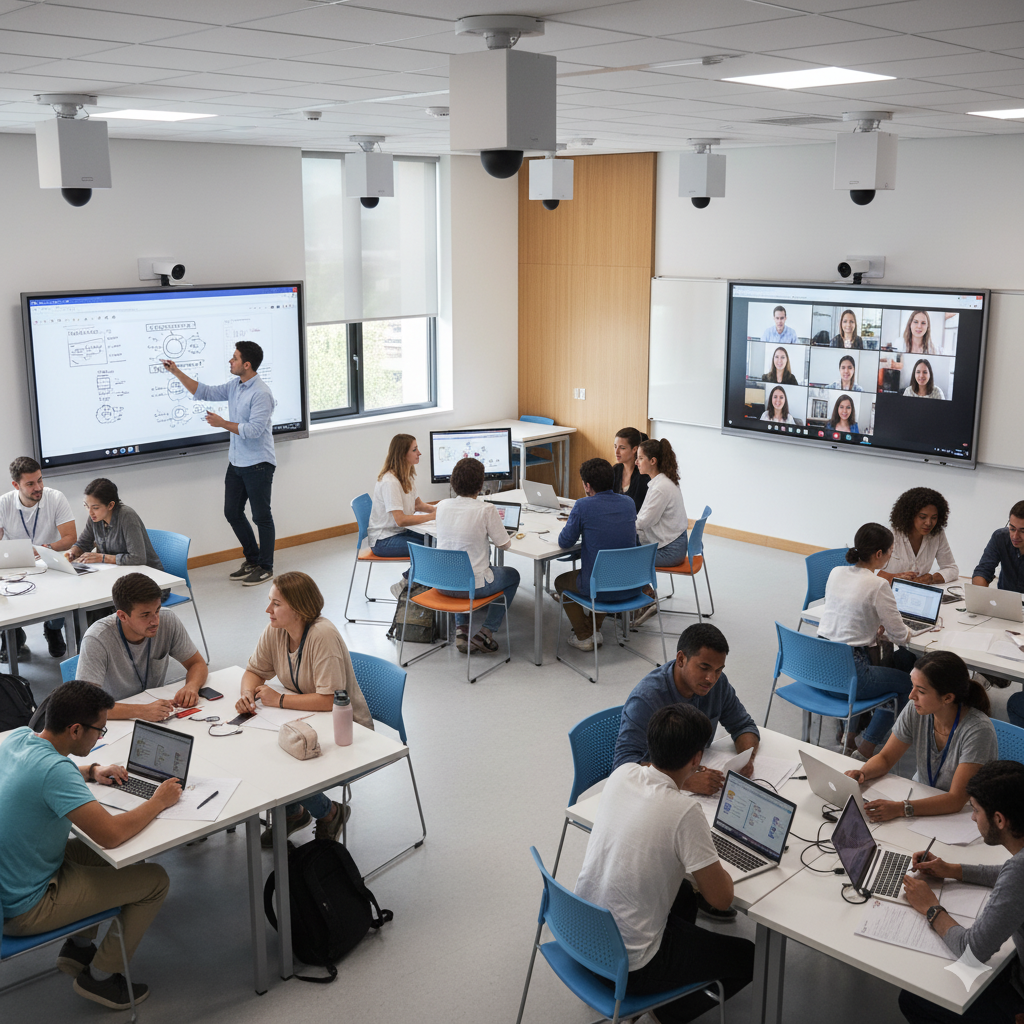Creating Adaptable Classrooms: Flexible AV Solutions for Dynamic Learning Environments

The traditional classroom, centered on a fixed chalkboard and rows of desks, no longer meets the needs of modern education. Today’s students thrive in dynamic learning environments that encourage interaction, project based work, and collaborative discussion.
For schools and universities, this shift requires more than just new furniture—it demands an intelligent technology infrastructure. At Audio-Video Group, we specialize in designing adaptable, state-of-the-art AV solutions that empower educators and allow technology to seamlessly support diverse teaching methods.
The Challenge: From Fixed Lectures to Fluid Collaboration
Contemporary pedagogy emphasizes several key instructional models that fixed technology systems often fail to support:
- Flipped Classrooms: Students consume lecture content before class, using in class time for application and group problem solving.
- Project Based Learning (PBL): Students work in small groups on long term projects, requiring shared displays, quick device connections, and flexible huddle spaces.
- Hybrid Learning: Instructors must engage students both physically present in the room and those joining remotely via video conferencing.
To successfully implement these methods, the classroom’s AV must be unbossed and unbought by rigid hardware—it must be flexible enough to change function in moments.
1. Collaborative Learning Spaces: AV Without Wires
The core of an adaptable classroom is the ability to share information instantly and seamlessly, regardless of where a student or teacher is standing.
| Traditional Method | Adaptable AV Solution |
| Fixed Projector: Only the instructor can share, and only to one screen. | Wireless Presentation Systems (WPS): Devices like Solstice or ClickShare allow any student or instructor to wirelessly connect a laptop, tablet, or phone and display content on the main screen with a single click. |
| Desk-Based Power/Data Ports: Students must physically move to a wall or central hub to connect their devices. | Room Zoning & Multiple Displays: Utilize two, three, or even four dispersed flat panel displays. These displays can simultaneously show different group work, transforming the room into a multi-focus collaborative zone. |
| Inconsistent Audio Capture: Remote students can’t hear student questions. | Ceiling Microphones: Discreet, integrated microphones suspended from the ceiling capture clear audio from every corner of the room, ensuring all participants—both remote and in room—are heard equally. |
By eliminating cables and centralizing control, the physical space can be reconfigured for group work, presentations, or full class discussions without requiring IT support to rewire the room.
2. Technology Integration for Diverse Teaching Methods
A truly adaptable AV system supports the instructor by minimizing technical friction, allowing them to switch teaching styles instantly.
Intuitive Control
A single, easy to use interface (such as a wall mounted touch panel) simplifies complex tasks. For example, a single button press can transition the room from a “Lecture Mode” (main display on, projector screen down, ceiling mics off) to a “Group Work Mode” (all wall mounted displays active, instructor’s content available for student access).
Robust Video Conferencing
For hybrid education, the system must create an equitable experience for remote learners.
- PTZ (Pan-Tilt-Zoom) Cameras: These cameras use presets or auto tracking to follow the instructor or focus on student groups when they speak, keeping remote students engaged and focused on the action.
- Annotation Devices: Interactive flat panels and digital whiteboards allow instructors to annotate notes in real time, with the resulting content instantly saved and shared with all students, regardless of location.
Auditory Clarity
High quality speakers, carefully integrated into the ceiling, ensure that video and audio content—and remote participants—are heard clearly over the noise of collaborative activities.
3. Future Proofing and Support
At Audio-Video Group, we know that educational budgets require longevity. Our solutions are designed with future proofing in mind:
- Scalable Infrastructure: We build the network backbone to accommodate future technology upgrades, like higher resolution screens or more advanced AI based cameras, without requiring a costly full system replacement.
- Training and Support: We provide comprehensive training to ensure educators are fully comfortable utilizing the new system’s flexibility from day one. Our continued servicing and support ensure maximum uptime throughout the school year.
An adaptable classroom isn’t just about the technology you install; it’s about the enhanced learning outcomes that dynamic teaching methods create. Partner with Audio-Video Group to design and integrate the flexible AV systems that will truly prepare your students for the future.

